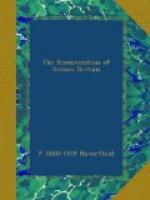Secondly, the distribution of civilian life, even in the lowlands, was singularly uneven. It is not merely that some districts were the special homes of wealthier residents. We have also to conceive of some parts as densely peopled and of some as hardly inhabited. Portions of Kent, Sussex, and Somerset are set thick with country-houses and similar vestiges of Romano-British life. But other portions of the same counties, southern Kent, northern Sussex, western Somerset, show very few traces of any settled life at all. The midland plain, and in particular Warwickshire,[1] seems to have been the largest of these ‘thin spots’. Here, among great woodlands and on damp and chilly clay, there dwelt not merely few civilized Roman-Britons, but few occupants of any sort.
[Footnote 1: Victoria Hist. of Warwickshire, i. 228.]
And lastly, Romano-British life was on a small scale. It was, I think, normal in quality and indeed not very dissimilar from that of many parts of Gaul. But it was in any case defective in quantity. We find towns in Britain, as elsewhere, and farms or country-houses. But the towns are small and somewhat few, and the country-houses indicate comfort more often than wealth. The costlier objects of ordinary use, fine mosaics, precious glass, gold and silver ornaments, occur comparatively seldom.[1] We have before us a civilization which, like a man whose constitution is sound rather than strong, might perish quickly from a violent shock.
[Footnote 1: See my remarks in Traill’s Social England (illustrated edition, 1901), i. 141-61.]
CHAPTER III
ROMANIZATION IN LANGUAGE
We may now proceed to survey the actual remains. They may seem scanty, but they deserve examination.
First, in respect of language. Even before the Claudian conquest of A.D. 43, British princes had begun to inscribe their coins with Latin words. These legends are not merely blind and unintelligent copies, like the imitations of Roman legends on the early English sceattas. The word most often used, REX, is strange to the Roman coinage, and must have been employed with a real sense of its meaning. After A.D. 43, Latin advanced rapidly. No Celtic inscription occurs, I believe, on any monument of the Roman period in Britain, neither cut on stone nor scratched on tile or potsherd, and this fact is the more noteworthy because, as I shall point out below, Celtic inscriptions are not at all unknown in Gaul. On the other hand, Roman inscriptions occur freely in Britain. They are less common than in many other provinces, and they abound most in the military region. But they appear also in towns and country-houses, and some of the instances are significant.




